By Nina Tabios
“If you told me in high school I’d end up as a university art teacher, I would have thought you’re crazy.”
Lo and behold, teaching is what takes up most of Karen Chesna’s time nowadays. A metalsmith of 25 years, Chesna has been an instructor and online coordinator for Academy of Art University’s School of Jewelry & Metal Arts (JEM) since 2016.
An Academy graduate herself—earning her M.F.A. in jewelry and metals from the School of Fine Art–Sculpture in 2010—Chesna returned to the Academy to spearhead JEM’s initiative to bring live video workshops to its online students. This spring, she’s teaching a few undergraduate and graduate courses from her home in Missoula, Montana.
Art U News spoke with Chesna about her extensive at-home work setup, her introduction into 3-D art and discovering the joy of teaching through her winding road of a career.
Can you describe your work setup? Do you work from home or do you have a studio?
I have the best of both! In my home studio, I have a three-by-four table that’s got all my soldering. I’ve got two torches with an oxygen-propane setup. I have another station where I’ve got my rolling mill, a drill press, and tools for forming and shaping metal. Another cool thing about my small studio is I have a portable sink. It has an instant-on heater built into it with two great big five-gallon jugs underneath it, one is for fresh water and one is for waste.
I also use two tree stumps, one piece of a Ponderosa pine that’s about three feet tall with an anvil on that and another shorter stump that’s about two feet tall that holds my dad’s old vise. I’ve got my jeweler’s bench and that’s very special to me. It was built by my mentor; we did a trade where I embroidered arts and crafts style pillows for him and he made me a jeweler’s bench which he signed at my request, so it’s very, very special to me. Your jeweler’s bench is like the cockpit of a plane—it’s the hub of everything and, like I said, mine is really special because of that personal connection.

You actually have a background in art history, studying Native American indigenous art. How did that lead to jewelry and metalsmithing?
I came to the whole world of art through the back door of craft. My mother sewed and I sewed. I worked in fiber for a long time and my undergrad degree was in indigenous art history, with a focus on native North American. I couldn’t draw as a kid—I’m more of a 3-D person—but I still loved art. I took an intro to art history class [in college] and got really interested in the Plains Indians and the artifacts that they made. So, as a senior, I volunteered at the Field Museum of Natural History [in Chicago]. I got to work with the Native American materials in the anthropology and conservation department and there, I met my friends Sylvia Schueppert and LeMoyne Mueller. They were fiber artists, and I realized through them, working with textiles and contemporary embroidery especially, I could be an artist.
What kinds of things were you making then? How did jewelry and metal arts come into your life?
Everything I did that was fabric-related became three-dimensional. I almost never did flat things. I loved boxes and containers and my fiber work went that direction. Fast forward a few years, we moved to Montana and my mother-in-law was taking a lost-wax casting class with a local sculptor. She said, “You should come and try it.” Since everything I was doing in fiber was 3-D, doing metal, I thought, “Okay, I’ll try it.” When I studied with the sculptor, she never told you exactly why you’d use a certain tool. She’d say, “Because it works,” and that wasn’t good enough for me. So, I signed up for a goldsmithing class at the community college to learn the “why.” And here we are now. It’s just this crazy series of rabbit trails–if you told me in high school I’d end up as a university art teacher, I would have thought you’re crazy.
What do you enjoy about teaching?
I think it’s that moment when somebody realizes, “Oh my gosh this is so hard, [but] I can do it.” Metalsmithing is one of the harder of the craft disciplines because it’s so technical, there’s a lot of science involved, a lot of precision, plus you can hurt yourself; there are so many facets to it. When someone comes in and they’ve never held a torch, they’ve never set a stone and suddenly they’re like, “I can do this,” it’s the best feeling in the world. Just empowering them to be able to do something so very hard. If you can learn to solder, you can do anything.
Since I was an online student, I definitely get it. I tell my students I have been where you are, I understand your triumphs and your challenges. I also taught on-site in a college goldsmithing program before I got my M.F.A., so I had good, solid on-site teaching under my belt to begin with. And the grad degree really solidified things for me, conceptually. I really understand what’s needed on both sides.
Do you still have time for personal projects?
I do! All of that background I have in indigenous cultures and from working in the museum, I still have this fascination with boxes and containers. I’ve never stopped exploring that. Right now, I have a little tiny shrine box on my bench and it has this overlay branch-like form. There is what will look like a flame at the top of it, and this little bit of red velvet in the background, like you would see in an old reliquary in a European church. I’m just looking for the perfect little thing to put into this shrine box. It’s very tiny, very hard to get into it, so I can’t set a stone or anything like that. I’m still figuring out what will be enshrined in there.
I also have a simple, silver bracelet that has a series of notches filed into it in a Fibonacci sequence (Sacred Geometry was one of my favorite classes at the Academy in grad school). I like work that’s like a code or mystery you’re trying to figure out. What are they trying to get at? What do they want you to try to figure out? My work is all about slowing down, taking time and questioning. Metals, in general, are like that too. It’s so labor-intensive, it’s such a focused activity. A lot of times, you make one mistake, you can’t go back—one degree too hot and you have a puddle!
What has been a guiding philosophy you’ve had throughout your career?
It’s been such a weird, long-winding career… I think I would say it’s to try to follow your nose. One thing opens up and leads to the next which leads to the next. Remain curious, not saying no. It’s to be mindful, following what captures your interest and not putting limits on that. It’s not saying, “Well I’m a fiber artist, so I can’t work in metal.” It’s looking at that bigger picture—it wasn’t the fiber that interested me, it was the creating containers and all that “inside and outside” can imply. So, it’s asking those questions, being curious, being open and paying attention.
